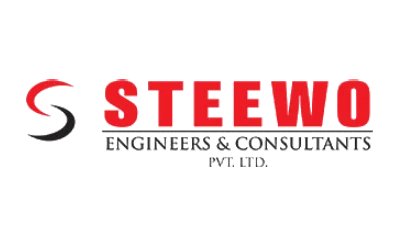In steel metalworking, a hot rolling mill is a metal forming process in which metal stock is passed through one or more pairs of rolls to reduce the thickness and to make the thickness uniform. At Steewo Engineers, we pride ourselves on our expertise in hot rolling mills, a cornerstone technology in the metalworking industry. Rolling is categorized based on the metal’s rolling temperature. The procedure is referred to as “hot rolling” if the metal’s temperature is higher than its recrystallization temperature. If the temperature of the metal is below its recrystallization temperature, the process is known as cold rolling. Hot rolling is the most widely used manufacturing process in terms of tonnage processed; cold rolling is the most often used cold working technique in terms of tonnage processed.
Roll stands, holding pairs of rolls, are grouped into rolling mills that can quickly process metal, typically steel, into products such as structural steel (I-beams, angle stock, channel stock, and so on), bar stock, and rails. Our hot rolling mills are designed to operate at a high level. They combine sophisticated automation, sturdy construction, and careful control systems to guarantee that the finished products are consistently of high quality and precise dimensions. Whether it’s for producing critical components in the automotive sector, structural elements in construction projects, or a wide range of industrial applications, our hot rolling mill stands as a testament to our commitment to innovation and excellence in metal fabrication.
Steewo Engineers implements the entire range of project engineering for your hot rolling mill from conceptual and detailed design to construction and start-up engineering. We create unique solutions just for you all over the world, depending on your final products and manufacturing volume. These range from entirely new facilities to equipment modernizations and maintenance plans for already-existing machinery.
How Do Rolling Mills Work?
Rolling mills use a series of two rollers or more, though the number of rollers might vary. The material is grasped by the set of revolving rollers, which propel it ahead. The material is then driven through an opening that is smaller than its starting thickness. The material’s thickness is decreased by the rolls themselves, resulting in a completed thickness that is lower than the initial thickness.. However, the adjustability in the roll gap allows the operator to run various thickness reductions using one set of tooling. This is the rationale behind the widespread usage of rolling mills as machines to adjust the thickness of different kinds of strips. The operator can control the process and make adjustments during production by using an integrated HMI station.
As previously mentioned, rolling mills come in a wide variety of forms. Rolling mills, on the other hand, work by passing different metals through one or more sets of rolls to compress loose material, reduce thickness, or establish a uniform thickness. Steewo Engineers rolling mills can be custom-designed and built to help metal manufacturers perform test runs to refine their processes for maximum productivity and efficiency. Numerous sizes and configurations of Steewo Engineers Rolling Mills are offered for a variety of engineering, manufacturing, and research and development (R&D) applications. Raw metal is first fed into the rolling mill, frequently in the form of billets or ingots. Hot rolling involves heating the metal to high temperatures, cold rolling involves processing the metal at room temperature or slightly below, depending on the type of rolling mill and the desired result.
FAQ’s of Rolling Mill –
What is Rolling mill in steel plant?
A rolling mill is a device that is used to roll sheet metal to manipulate it, as the name implies. Rolling mills are used to compress metal to a consistent thickness, bend it into unique forms, and make stripping with specific dimensions.
What are the advantages of using a rolling mill?
Using rolling mills has several benefits, such as better surface polish, decreased material waste, enhanced strength and consistency of the metal, and the capacity to create a large variety of shapes and sizes.
How does a rolling mill work?
In a rolling mill, two rolls slide metal between them, applying compressive pressures that cause the material to take on the required shape. The intended result might determine whether the rolls revolve in the same direction (tandem rolling) or in different directions (opposite or reverse rolling).
What is the purpose of rolling mill?
Rolling mills are used to compress metal to a consistent thickness, bend it into unique forms, and make stripping with specific dimensions.
What are the raw materials of rolling mill?
The rolling procedure is a form of cold forging. Numerous materials, including low-carbon steel, stainless steel, aluminum, galvanized sheet, and more, can be utilized for rolling forming.



